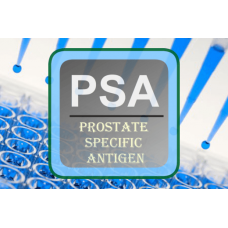Shopping Cart
0 item(s) - $0.00Prostate-specific Antigen ELISA - PSA
Availability: In Stock
Add to Compare
Enzyme Immunoassay for the Quantitative Determination of Prostate Specific Antigen (PSA) in Serum
FOR RESEARCH USE ONLY. NOT FOR USE IN DIAGNOSTIC PROCEDURES
SUMMARY
Prostate-specific antigen (PSA), also known as gamma-seminoprotein or kallikrein-3 (KLK3), is a glycoprotein enzyme encoded in humans by the KLK3 gene. PSA is a member of the kallikrein-related peptidase family and is secreted by the epithelial cells of the prostate gland. PSA is produced for the ejaculate, where it liquefies semen in the seminal coagulum and allows sperm to swim freely. It is also believed to be instrumental in dissolving cervical mucus, allowing the entry of sperm into the uterus.
PSA is present in small quantities in the serum of men with healthy prostates, but is often elevated in the presence of prostate cancer or other prostate disorders. The United States Preventive Services Task Force (USPSTF, 2012) does not recommend PSA screening, noting that the test may result in overdiagnosis and overtreatment because "most prostate cancer is asymptomatic for life," and treatments involve risks of complications including impotence (erectile dysfunction) and incontinence. The USPSTF concludes "the potential benefit does not outweigh the expected harms." PSA is not a unique indicator of prostate cancer, but may also detect prostatitis or benign prostatic hyperplasia. 30 percent of patients with high PSA have prostate cancer diagnosed after biopsy.
PRINCIPLE OF THE TEST
The PSA ELISA test is based on the principle of a solid phase enzyme-linked immunosorbent assay. The assay system utilizes a goat anti-PSA antibody directed against PSA for solid phase immobilization (on the microtiter wells). A monoclonal anti-PSA antibody conjugated to horseradish peroxidase (HRP) is in the antibody-enzyme conjugate solution. The test sample is allowed to react first with the immobilized goat antibody at room temperature for 60 minutes. The wells are washed to remove any unbound antigen. The monoclonal anti-PSA-HRP conjugate is then added and allowed to react with the immobilized antigen for 60 minutes at
room temperature resulting in the PSA molecules being sandwiched between the solid phase and enzyme-linked antibodies. The wells are washed with water to remove unbound-labeled antibodies. A solution of TMB Reagent is added and incubated at room temperature for 20 minutes, resulting in the development of a blue color. The color development is stopped with the addition of Stop Solution changing the color to yellow. The concentration of PSA is directly proportional to the color intensity of the test sample. Absorbance is measured spectrophotometrically at 450 nm.
EXAMPLE OF STANDARD CURVE
Results of a typical standard run with optical density readings at
450 nm shown in the Y axis against Prostate-specific antigen concentrations shown in the X axis. This standard curve is for the purpose of illustration only, and should not be used to calculate unknowns. Each user should obtain his or her own data and standard curve.

| General | |
| ANALYTE GROUP | Prostate Specific Antigen (PSA) |
| GROUPING | Cancer:Reproduction |
| PRODUCT NAME | ELISA |
| STORAGE | Store the kit at 2-8°C |
| COUNTRY OF ORIGIN | USA |
| DISCOUNTS | Bulk Packaging; High Volume |
| ELISA | |
| TESTS PER KIT | 96 (12 x 8) |
| CALIBRATION RANGE | 0 - 120 ng/mL (Recommended) |
United Immunoassay, Inc. © 2025


































